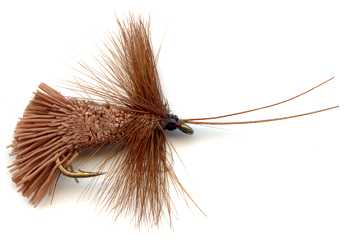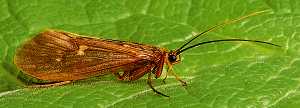Goddard's Brown Caddis (G & H Sedge) Fly
If you like to go flyfishing for trout in a boat on Lakes and reservoirs then the Goddards Brown Caddis fly is ideal as a top dropper on a rig of three to four flies. It mimicks a female caddis coming back to the water surface to lay eggs which fish find a tempting target.

GODDARD'S CADDIS FLY PATTERNS. Hook size 10 12 14 16 18 - $US each - Great for rough water
If you fly fishing for trout in late July and August evenings, I use a caddis imitation as a top dropper Bob fly. The Goddard's caddis also known as the G & H sedge fly, can fool trout into thinking that it is a female caddis on the water surface laying her eggs. It has just the correct silhouettes to deceive hungry fish. When fishing from a boat on the reservoir on Lake, I use fishing rods that are slightly longer than normal. Normally between 10 foot to 12 foot is ideal. I want to get the flies as far away from the boat as possible but still regain control.
Perfect summer days, for fly fishing for trout on large areas of Stillwater, are cloudy days with warm winds. Unlike on cold days, your target fish will be exploring the upper area of the water column the food. I cast a rig of 3 to 4 flies. The point fly is normally heavier than the other flies. This could be a beaded fly like a pheasant tail, or a hook size 10 or 12 gold ribbed hares ear nymph. The middle dropper fly will be lighter and on a smaller hook. The top dropper fly is normally a large dry fly. Its purpose is to allow you to gauge if there is interest on the flies dangling below it, and also to make a disturbance on the water surface that shouts to the lurking fish in the depths, "hey, you guys, there is something good to eat up here".

Normally you will use a floating line but be prepared for the weather to deteriorate. When winds pick up and the water becomes more choppy, you need more control on the fly. This is when you need to change to a fast sinking line. This line does not get blown around all over the place like the floating line does when the wind picks up. Hold the road up high and you will be up to manoeuvre it with great accuracy.

This is fly fisherman John Goddard designer of the Suspender Buzzer fishing for grayling on the river Kennet


Goddard's fishing books

